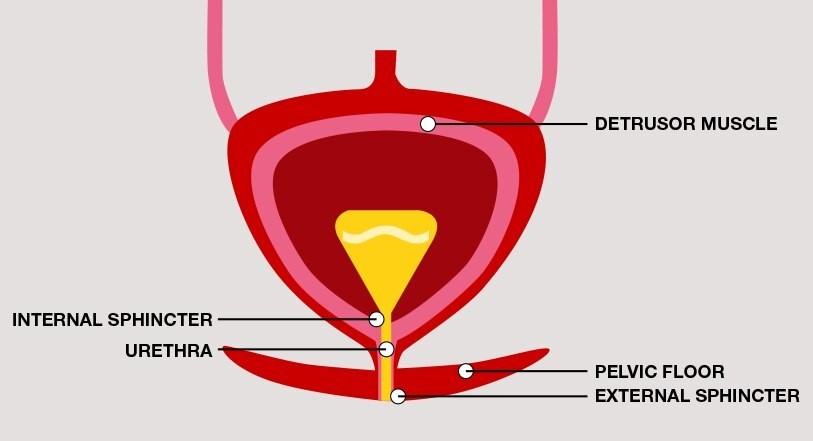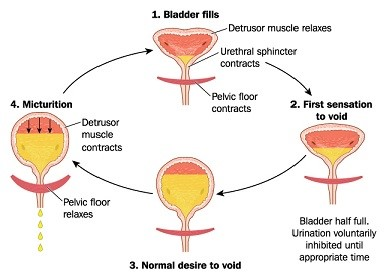
We all are born with a bladder, but how exactly does the bladder work?
More importantly, why should you care?
Many of us – particularly women – deal with issues like overactive bladder, bladder pain, and/or incontinence.
It is miserable to have to plan multiple bathrooms stops on a road trip or having to constantly worry about being able to make it to the bathroom in time.
But what if I told you it doesn’t have to be this way?
Before we dive into how we treat these conditions, (SPOILER ALERT – YES! We can successfully treat all of the issues listed above!) it is important to understand more about how the bladder should function.
The Role of the Nervous System
There are two subdivisions of the Autonomic Nervous System, known as Sympathetic and Parasympathetic.
The Sympathetic Nervous System promotes continence and gives your brain information about when you need to void.
The Parasympathetic Nervous System allows you to empty your bladder when it is time to do so by helping the muscles in your pelvic floor to relax.
There is an amazing mind-body connection between your brain and your bladder-emptying muscle, the detrusor.
The detrusor is made up of smooth muscle (or involuntary muscle) and is controlled by your Autonomic Nervous System.
The external sphincter is one of the muscles of your pelvic floor. It is a voluntary muscle under conscious control. In other words, you can consciously decide when to contract it or relax it.

Thus, both different types of muscle exist in the same system, and these muscles and systems were designed to work together in harmony.
As your bladder fills, nerves send signals to your brain, letting it know that your bladder is beginning to fill.
The brain interprets this information and then responds with a signal telling your bladder to wait or void.
Your brain instantly interprets these nerve signals, not only in the physical context of your bladder filling but also in the emotional and social context.
For instance, are you in an appropriate place or situation to void?
Based on the information received by your brain, a decision is made and signals are relayed to your bladder to either continue to fill or begin to void.
During the filling phase, the voluntary contractions of the pelvic floor join the autonomic control and resting tone of the internal sphincter. This allows the bladder to expand without loss of urine.
The emptying phase begins once the bladder has reached its capacity AND when we are ready to void, which demonstrates the necessary coordination between your muscles and your nervous system.
At this point, you need relaxation of the internal and external sphincters and active contraction of the detrusor.

Unfortunately, there are many people who are unable to coordinate these two systems in a way that allows for ideal filling and voiding throughout the day.
How do urges work?
Think of urges like little conversations from your bladder to your brain, similar to hunger signals from your gut.
As the bladder fills and stretches, you feel different types of urges to void or empty your bladder.
The first urge is a quiet little suggestion when the bladder is around 40% full. It’s just background information and can be easily ignored.
The second is a stronger reminder – this is when you know you should be making a plan to find a bathroom in the near future.
The third is a bit louder and really gets your attention. It is normal at this point to feel some discomfort or “pressure” as the detrusor muscle is encroaching on the bladder. At this stage, your bladder has reached about 75% fullness and it’s time to go!
So if these urges are normal, how often should you urinate?
The normal range for urinating is 6-8 times during the day and 0-1 times at night, which equates to once every 2-4 hours.
We know that there is an issue with your bladder and pelvic floor when your diary (yes, our clients keep a bowel/bladder diary!) shows us you are going 10-15x in the day and multiple times at night.
How much is a normal urinary volume?
A healthy bladder can stretch to hold 400-600 mL of urine (think of a grande latte!).
Try to visualize the bladder like a balloon that slowly fills with water, stretching to accommodate the fluid. When your bladder reaches its capacity, or approximately 75% full, this is the time to find the nearest bathroom!

As you sit down on the toilet, your brain should tell your pelvic floor to relax, which then allows the detrusor to squeeze the bladder and release urine.
How much force should it take to void my bladder?
None! You should be able to relax and void without straining. The detrusor muscle is doing all the work as your pelvic floor relaxes.
Have you ever noticed that you need to “push” your pee out or “power pee”?
This can be a tell-tale sign of chronic pelvic floor tightness (hypertonicity).
Your stream can also give us information. It should be steady and typically last around 10-12 seconds.
If your pelvic floor does not relax, then your bladder is not getting the message or signal to contract and empty.
If you are contracting your pelvic floor while sitting on the toilet, then you are unintentionally fighting your body’s natural relaxation reflex, which causes a “flow and stop” effect rather than a steady stream.

So now that you know how a healthy bladder functions, it will be easier for you to understand how bladder function goes awry.
In the next post in this series, I discuss one of the most common types of bladder dysfunction – The Overactive Bladder.
Continue to follow along throughout this series to learn treatment techniques for each unique type of bladder dysfunction!
For now, just know this – there is hope! You don’t have to live the rest of your life within arm’s reach of the nearest bathroom!



